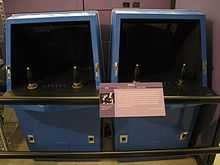Galaxy Game

Galaxy Game is one of the earliest known coin-operated computer/video games. It was installed at the Tresidder Union at Stanford University in September, 1971, two months before the official release of Computer Space, the first mass-produced video game.[1] Only one unit was built initially, although the game later included several consoles allowing users to play against each other.
The game was programmed by Bill Pitts and Hugh Tuck. Like Computer Space, it was a version of the existing Spacewar!, which had been created in the early 1960s on the PDP-1 and had since been ported to a variety of platforms. The coin-operated game console incorporated a DEC PDP-11/20 with vector displays. The hardware cost around US$20,000 ($116,466.72 today). In June 1972 the hardware was improved to allow the processor to power four to eight consoles.[2]
A game cost 10 cents or three games for 25 cents. It remained popular on campus, with wait times for players as long as an hour, until it was removed in May 1979 due to the display processor becoming unreliable.[2]
The unit was restored in 1997 and is now in the collection of the Computer History Museum in Mountain View, California.[3] In August 2010, the museum loaned the console to Google for display and gameplay at the Googleplex, their headquarters campus.[4]
References
- ↑ Ed Thelen (December 2005). "Computer Recreations, Galaxy Game". Retrieved 2011-08-19.
- ↑ 2.0 2.1 Bill Pitts (October 29, 1997). "The Galaxy Game". Retrieved 2011-08-19.
- ↑ "Galaxy game". Computer History Museum. Retrieved 2011-08-19.
- ↑ Patrick May (August 18, 2010). "At Google, 1970s Coin-Operated Video Game Provides Inspiration". San Jose Mercury News. Retrieved 2011-08-19.
External links
- Article about the Galaxy Game from Stanford University (October 2009)
- Galaxy-Game machine from Stanford University
- Galaxy Game information from arcade-history.com